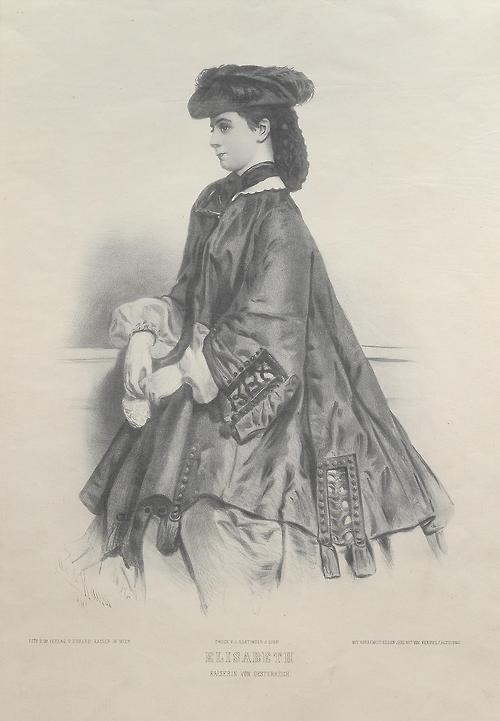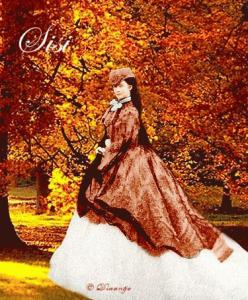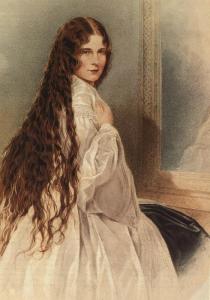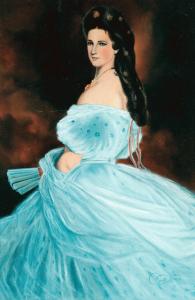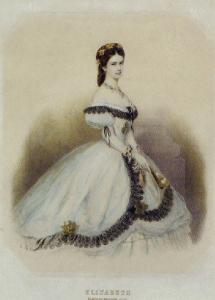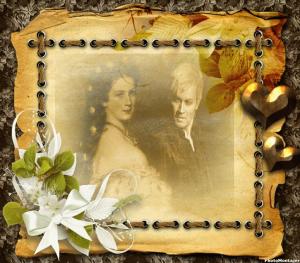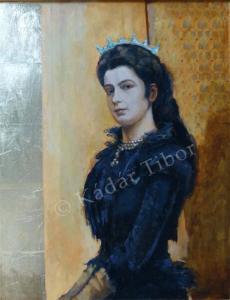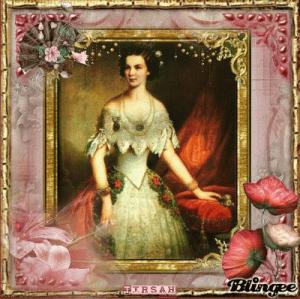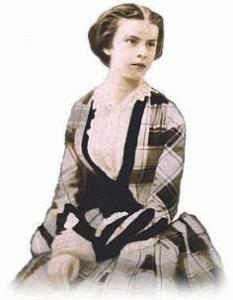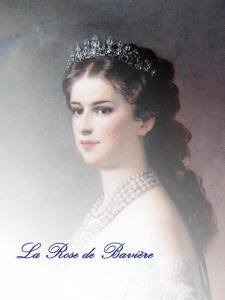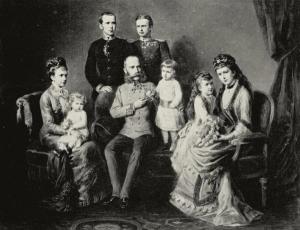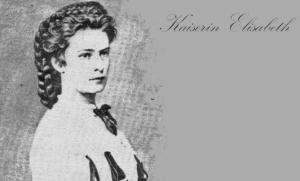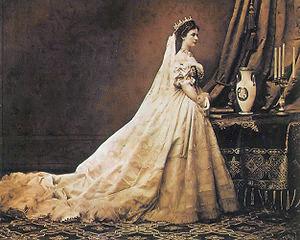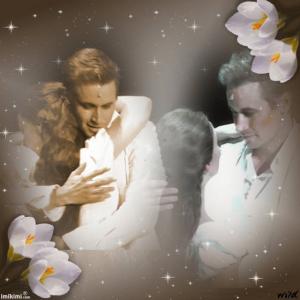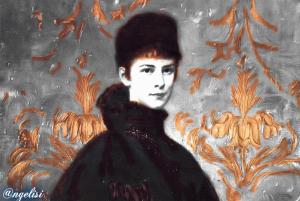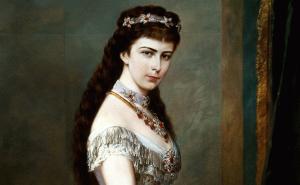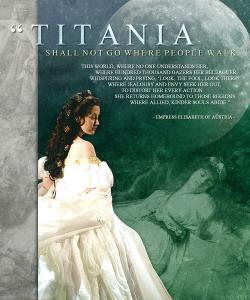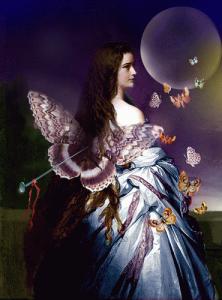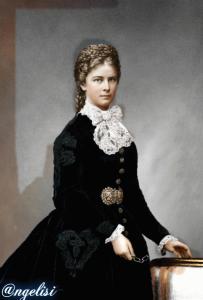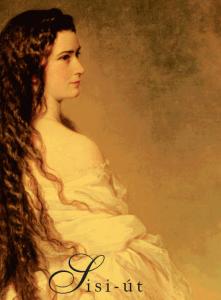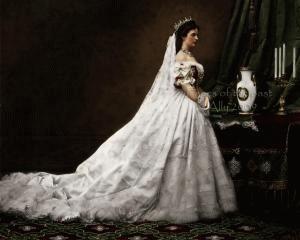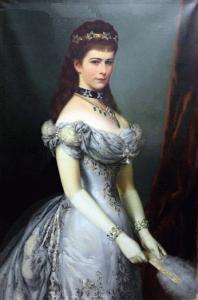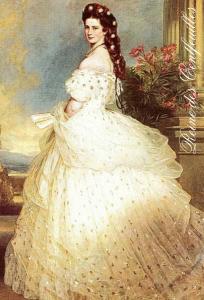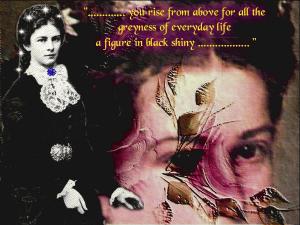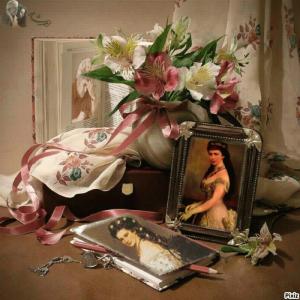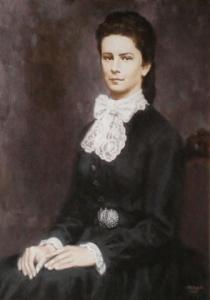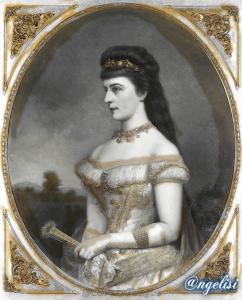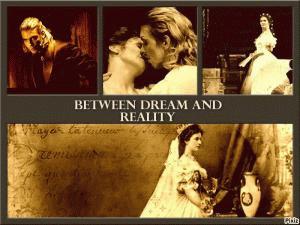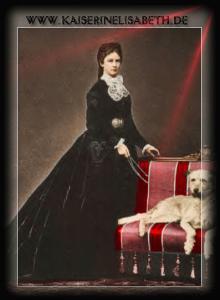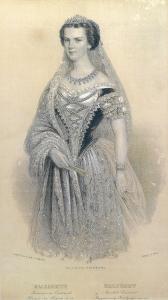Rudolf child
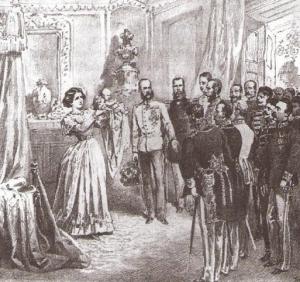
21 August 1858 the birth of Rudolf ..................for this son a little love
Rodolfo was born August 21, 1858 at the palace of Laxenburg, near Vienna. One hundred and one guns fired blanks to announce the arrival of the first prince from the times of the fool Ferdinand I in 1793 and the entire monarchy took part in the festivities. The real home made numerous donations to many charities, although at that time the state finances were rather small. It had only been 10 years since his father, Emperor Franz Joseph, had re-established with great difficulty the authority of the Habsburgs in 'Austrian Empire .......................... Now the Habsburgs had a joyful triumph of reason, the birth of a healthy heir to the throne, so anxiously desired and prayed for had been accomplished. ...................... The name given to the infant at the time of baptism was symbolically significant, Rudolf of Habsburg was the illustrious founder of the longest reigning dynasty in Europe. The Crown Prince was the repository of hopes in the course of his life would have become an increasingly heavy burden .............. The Emperor Francis Joseph, then twenty-eight, was extremely confident and happy. He finally had a firm control of his domain, with no obvious immediate threats ...................... The emperor saw the birth of her third son, Rudolf, heir to the throne and a guarantee for the security and uninterrupted continuation of the Habsburg rule for the coming years ............... .............. The hopes reposed in FJ son were clear right from the cradle, in the literal sense of the word. Rodolfo had to see unfold his career and his future in the army. Rodolfo's mother, the Empress Elizabeth of a Bavarian duchess Rammo side of Wittelsbach, at the time of his birth was an immature 20 year old woman who was facing personal problems ............ ...... In those years, unable to assert their own personality face to face with her domineering mother-in-law, the Archduchess Sofia. Elizabeth soon renounced their rights and responsibilities as a mother. Rodolfo became his third son, only to be ripped and place physically and mentalemente wing of the royal palace inhabited by the mother-in-law.
from "Rebel Real" psychological portrait of Rudolph of Hapsburg of John T. Salvendy Publisher: Murcia
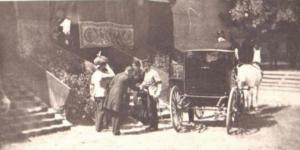
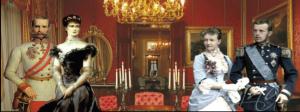
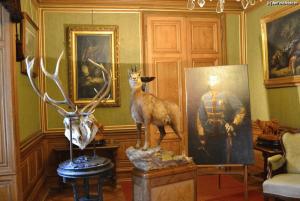
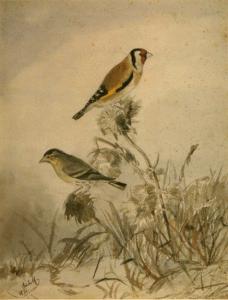
If you want read the entirely books write by the Crown Prince Rudolf go this link , the text is in English language :
https://archive.org/stream/notesonsportorni00rudo#page/n13/mode/2up
Notes on Sport and Ornithology
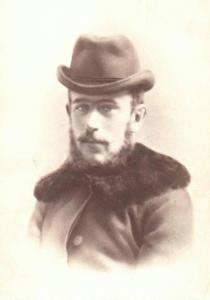
The passion of the Crown Prince Rudolf for the Onithology
Under the influence of the outstanding team of academics assembled to teach him, the crown
prince early began to show great interest in the natural sciences. Rudolf's passionate enthusiasm
for birds is evident in his drawings from early childhood and in his compositions. He wrote his first
lengthy essay entitled Adlerjagden [Eagle Hunts] at the age of just twelve. The heir to the throne
eventually published a total of 40 ornithological works which were commended by leading experts
in the field. His most intensive scientific correspondence was with the zoologist Alfred Brehm.
Rudolf invariably combined observation of birds in their natural habitat with the pleasures of the
hunt. The specimens he obtained in this way served him in his research into European species of
birds of prey and gallinaceous birds, which were his special field. These specimens were then
displayed in the ornithological museum he had set up in his private apartments in the Vienna
Hofburg.
Besides his passion for ornithology, the crown prince was also interested in minerals and rock
formations. He left his ornithological specimens and mineralogical collections to the Natural History
Museum and the Universität für Bodenkultur.
On 22 March 1876 the Ornithological Association of Vienna was founded, followed
shortly afterwards by the publication of the first number of the association's journal. In the
same year the crown prince became patron of the association. Rudolf published a total of 18
ornithological essays in the association's journal. Like all his anonymously published
articles, this essay is marked with an asterisk in the first line of the text.
The Crown Prince Rudolf
was among the pioneers in the field of the protection of birds. In recognition of his efforts he
was awarded a honorary diploma by the German Association for the Protection of Birds on 6
December 1882.
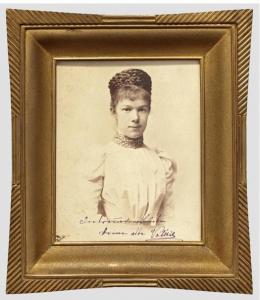
Marie Valerie of Austria (1868 - 1924) - Photos with personal dedication
The dedication in ink "In true love - your Valerie." In golden, metallic copper colored frame measuring 20 x 17.5 cm. Photos very rare at 20 years of favorite daughter of Empress Elisabeth of Austria.
Rudolf : the heir to the throne ...... the abandoned child
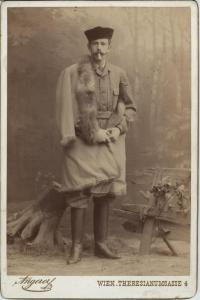
Rudolf of Hapsburg - a fascinating mystery
When you want to talk about Rudolph of Habsburg we always start from there : Mayerling , January 30, 1889 , the day in which not only the life of a family but also the whole of Europe suddenly changed . It was exactly 125 years since the death of her only son of Emperor Franz Joseph and Elizabeth, so much so that even strange rumors circulating about an alleged plot against the heir to the throne.
But who was the scion of the Hapsburgs and because it was so dangerous in the eyes of his contemporaries ?
Intelligent, sophisticated and discerning what it looks like Rudolph from his early youth , with traits derived from the Habsburgs yes but most belong to the maternal branch of the Wittelsbach . Heir to the throne is assigned a childhood curriculum abnormal that will undermine the physical and even the fragile psychic equilibrium .
Deep knowledge of foreign languages , with which it will stand out in his many travels within the Empire , but he will focus more and more to the study of the natural sciences especially ornithology , studies that will never delve into the University as the father will direct them to a military career . Life as a " soldier " will not prevent , however, to Rudolph to continue his passion and prepare some works (the most famous is " Fifteen days on the Danube " ) depth on the subject.
Military life , the feverish activity as a scholar , as well as interests "lighter " but keep away from politics Rudolph the Hofburg , but not deliberately , as to not introduce it in the " control room" is just Franz Joseph. He fears and distrusts this son he calls " chatty " , does not like the circle of friends and associates whom he surrounds himself (especially Jews and Masons) and criticizes the liberal ideas of the child, in particular with regard to alliances international and domestic institutional structure .
Rodolfo bear this ache , feeling the large clouds that are gathering on the Danube monarchy , began to write articles signed with the pseudonym " Julius Felix" in the newspaper " Wiener Tagsblatt " friend Moritz Sepz . Over the years, Rudolph will be increasingly watched by the police Taafe the prime minister and the chief of police in Vienna Kraus , on suspicion of plotting against the Empire itself.
The parable of the Crown Prince is coming faster and faster at the end of the race. At 23 years old he married Princess Stephanie of Belgium, and after the first few years of serenity double culminated with the birth of their only daughter Elizabeth, he will resume a life quite tiring and , due to depression, back to the ancient vices : alcohol and women . After a love affair with a gypsy dancer contracted gonorrhea and then infect his wife , with the unfortunate result that can not have more children.
All this pushes Rudolph more and more into the abyss , and the complicity of the disease begin to make use of morphine. 1888 will be a disastrous year , because despite the sympathy that still enjoys among the subjects of the empire , Rodolfo will do anything to be in contempt of the imperial family , going so far as to shoot his father during a hunting party in Muerzteg . Fortunately, being shot in the arm has been a diligent participant at bat, covering his Emperor and avoiding a tragic ending to that episode.
As a result of this incident Rodolfo will be held at a safe distance from his father who will not trust more than him, and this will affect even more about his fragile personality. Therefore propose to girlfriend ever ( the whore Mitzi Caspar ) a suicide pact , she categorically reject and will instead reply with the latest mistress, Mary Vetsera , he at age 30 and she was only 17 .
There are plenty of " legends " that circulate on this case : who speaks for internal plot ( hatched by Taafe and conservatives ) , who track international ( German and French ) , who even absurd plots family (hence the work of Franz Joseph ) , who think about issues of integrity (think Baltazzi brothers , uncles of Mary Vetsera ) . Even Zita of Bourbon - Parma , the wife of the last emperor Charles I, had promised to reveal the truth about the case Mayerling , but in its centuries-old existence has not revealed anything.
The truth is ultimately the most sad and banal. Rodolfo has always had a weak character compared to his father , a political vision too early compared to the times, and a predisposition to depression characteristic of the maternal line . Definitely a temper and a greater consistency , combined with a patient waiting would have prevented the decline of this promising psychological scion imperial and perhaps the course of future events could take a different value . But here (unfortunately) remain in the field of "maybe."
From the site: http://www.quivienna.com/storia-dellaustria/rodolfo-dasburgo-un-affascinante-mistero/
Sissi Empress sad, unhappy mother
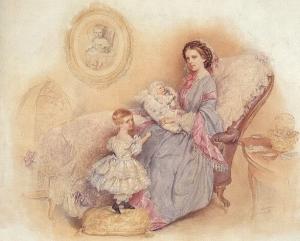
Sissi Empress sad, unhappy mother
by Mariateresa Truncellito..
It seems out of a fairy tale: the princess is 24 years old eindossa a white dress, like a fluffy cloud. The bare back, the hair pelledi porcelain and a complex quilt of diamond stars. Tral hands, a fan. Watch the amused observer, aware of suastraordinaria beauty. It is the most famous portrait of Elizabeth of Austria, To all simply known as Sisi or Sissi in his kingdom. But in quadropreferito by her husband, Emperor Franz Joseph, melancholy appears, wearing a nightgown and long hair curiously annodatisul breasts, totally unadorned. Who is the real Sissi? The protagonist of the last dellefiabe, as we have described the three famous movies of RomySchneider? Or a woman unhappy and tormented, as shown in psicobiografiadi Gabriel Praschl-Bichler (The Empress Elizabeth, Tea)? Un'anticonformista, victim's mother-in-law's stiff and ceremonial corteAsburgica or a lady proud and moody, separate from her children and maritoperché too taken by itself? To seek confirmation or denial, tens distorici have spent his life under an unforgiving microscope. The fate runs toward her very soon, when ancorapresa from his childhood games. It's the summer of 1853. Sissi has just 15 years: a girl is very attached to her father, Duke Maximilian of Bavaria, colquale shares his passion for the ancient world, the harp and the circus. Suamadre, Ludovica, and his aunt, the Archduchess Sophia, mother of the heir to tronod'Austria Francis Joseph, have devised a perfect plan: meet in Bad Ischl, a charming spa town not far from Salzburg, the engagement of their perfavorire sons. The choice, however, is not Sissi, but more Lasorella Elena Nene, who had long been prepared for the role diimperatrice: is of a quiet, is obedient, and distinct educatissima.Per not to arouse too much suspicion, Ludovica brings, as a chaperone, even the little Sissy. The meeting between the two young men, however, is wrong: Nene èagitatissima and "Franzi" finds her features are too hard. Ditutt'altro spirit is the youngest sister, the alien conspiracy. The suaallegria and her confidence hit the cousin, who falls in love with Primavista. Although frightened by the prospect of becoming empress, neppureSissi remains indifferent to the charm of Francis Joseph, is beautiful, young (25 years old) and is the most eligible bachelor in Europe. Sissi sadell'amore What he learned from reading romantic: if for life silascerà go to the dreams and fantasies, let alone 15 years. Almenoall'inizio, sincerely reciprocate the feelings of Franzi. But over deglianni would become impatient spouse. And he said: "The senseless matrimonioè institution. Do you sell, child of fifteen, and ungiuramento do not understand and you can not dissolve anymore. " Before the wedding, Sissi is subjected to a complicated ceremonial rigidoapprendistato the Spanish court Asburgica.Dopotutto, is "only" the daughter of a duke, and not the scion of unsovrano. It is very beautiful, yes, but it has yellow teeth: so must learn acontenere his laughter. His mood worsens and it always feels piùmalinconica. On April 24, 1854 the church of the Augustinians dirosso is decorated and lit by 15,000 candles. Sissi wears a white dress, constrascico, quilted gold and silver. On his head is a crown, donodell'arciduchessa Sofia, and chest a bunch of white roses. She is pale, tesae not look around. The "yes" is little more than a whisper. The next morning, the waiting for a nasty surprise: the tavoloper breakfast is not only prepared for two romantically. Among ipresenti, there is also the mother-in-law. Years later, Sissi would be remembered as "a horrific experience." From the accounts of Franzi's mother, we know that the marriage was consummated only on the third night. Elisabettaè very modest. The long festivities they require the hearings, presentations, dinners. Wherever she is welcomed by great affection and enthusiasm. But she sisente uncomfortable, scrutinized by a thousand curious eyes. The Court does not like life. She misses her family Inspectorate, with contact by letter which will take forever. Francis Joseph is sempreoccupato to rule the Empire. And everything is part of Archduchess Sophie, who nonfa nothing but criticize. If only he could to gallop alone with isuoi loved horses ... But you can not, for safety reasons: Sissi devemuoversi always with the ladies of the company that has chosen for her mother-in-law. Percontrastare boredom, is dedicated to the study of languages and literature, andthe poetry. Occasionally, the Court invites you to his family: as sorellinaMaria, with which, at night, she finds herself barefoot on the carpet of the Hofburg afumare secretly. The conflict with the mother-in-law gets worse at birth dellaprimogenita Sofia's grandmother believes that the seventeen year old daughter is not ingrado to deal with the education of his daughter. So seizes the neonatanei his apartments. The same will happen next year, with the birth diGisella and, later, with the Crown Prince Rudolf. DiSissi maternal instinct, however, biographers all agree: according to some, the only bothers odoredei infants, while in his memoirs, the niece of Empress Mariariferisce this statement: "The children are the mothers because they destroy the maledizionedelle their beauty, while this is the only and is unique gift that God sends us. " In fact, in 1857, when little Sophia siammala seriously, Sissi decides to follow her husband on a trip inUngheria, which is much loved. They return at the end of the tour planned, just intempo to assist the child's death. Maybe even later. In 1860, the first solo flight: Sissi is distressed, iconflitti mother-in-law with increasing frequency. Weakened by three parts inquattro year, ostensibly to spend the winter in a warm part of the Mediterranean voltadel: Madeira, Cadiz, Seville, Gibraltar, Majorca, Malta and Corfù.Salvo a quick return, it would be almost two years later returned to Vienna. In his writings, Sissi accuses the mother-in-law of averlesottratto children. But is she, turning the length and breadth of Europe, let alone for months. Only in the face too basic education chegli impart to Rudolph Habsburg, who has not yet 6 years, Elisabettaannuncia of wanting to occupy him personally. But after a few weeks, Edi road again. Much to the chagrin of the child. In addition to travel, poetry and the occult (the empress claimed to be in contact media, among others, Heinrich Heine colpoeta) Sissi seeks refuge from misery in itself. Inparticular, in taking care of her legendary beauty obsessively. You altaun meter and seventy-two, weighs 48 pounds, has a life of only 56 cm. Perottenerla at night sleep with a wet towel wrapped around his waist and wearing digiorno a bust that requires an hour of hard work to be closely alpunto right. To emphasize the silhouette, it does not just sew clothes addosso.Ma: is dedicated to grueling rides and long walks-running. Practice the fencing and a couple of hours of daily exercise. Dedication to treore long golden brown hair, under the care of Franziska Feifalik, the hairdresser became so intimate occasions to replace ufficialiin which is visible only from afar. Sissi eats very little, sometimes nothing. But he loves lacioccolata, cream cakes, ice cream and champagne. Allagolosità when you let go can enjoy the company of brothers. But preparing aquesti meetings experiencing any sort of weight-loss diet: cold milk, raw eggs, Tokaj wine, vegetable broth, raw meat beef. Mark on undiario measures vital, taken several times a day, and every gram of pesoperso. A legend even eat sitting on a balance. Percurare skin, apply on face masks, horse meat and strawberry, and make warm baths in olive oil. When riding, not to ruin her hands, wearing three pairs of gloves overlap. A Court, Sissi is not very popular: it shows little, avoids iricevimenti, speaks only in Hungarian, because it has replaced all the ladies with Austrian dicompagnia titled noblewomen eat or not. As Ida vonFerenczy and Countess Maria von Festetics and niece Maria Larisch-Wallersee, daughter of his brother Luigi, an actress, so the rank of "inferior". Often goes with them to go shopping incognito, maanche to swim in the sea, contrary to every principle of decency. Questeamicizie female, together with the habit of collecting portraits and photos dibelle women of various nationalities, would have given birth in more than a suspicion that biografoil Sissi was a lesbian. Instead it is a fact that those links never nonsuperarono the limits of friendship. Beautiful as it is, Elizabeth enjoys playing with sentimentidi numerous suitors. Including the Prince of Wales, the future EdoardoVII, one evening, he receives in his dressing gown with lace. But when he goes to piùardite advances, the Empress, who had first agreed on the joke, siaffretta calling loudly for his niece Maria. Just you wrote: "Erainnamorata love. He enjoyed the adoration of men as a tribute dovutoalla its beauty. But his enthusiasm never lasted long: suasensibilità was too contrived to engage the senses. " Digrande importance however is the link with the Count Gyula Andrássy, who lacoinvolge the Hungarian cause. Beautiful, attractive, with notevoletemperamento, falls in love with the Empress. During the stay in Hungary, idue spend much time together, although historians believe that larelazione never exceeded the bounds of propriety. Francis Joseph (although it is known not to hesitate in aimbarcarsi adventures) assigns to every whim. In her many letters, nonfa to reiterate his love and beg her to return to Vienna. Nell'estate1866, during the battle of Sadowa, where the imperial troops are sconfitteda which Prussians, calls for his presence. Sissi agrees, but the meeting did not èfelice. He writes: "Come back soon, because, although this time you stataparecchio bad and annoying, I love you infinitely good, so that not sovivere without you." Just through the intercession of his wife, Francis Magyar Giuseppefinisce to accommodate the aspirations of equal dignity with Austria in 1867 he and Sissy also become king and queen of Hungary. Some biograforitiene the subsequent pregnancy of the Empress was a "prize" for the emperor. A rumor, however, gives lapaternità to Count Andrassy. In fact, Sissy chooses to give birth to their MariaValeria in Hungary, in 1868. The youngest will figliaprediletta, the only one who will bring with it Sissi in his travels. In the mid-eighties, Sissi poesiel'esaurirsi complains in his love of the emperor. But she is, that most of the time, wanted to be left alone. The valet Franz Joseph Eugen Ketterl, said: "If the emperor was without preavvisonelle rooms of the Empress, the staff explained that she stavaancora sleeping. Instead, not infrequently, the illustrious lady was already in the mountains, daiquali fell only in the evening: and tired, was less willing than ever aricevere the emperor. It often happened that he tried unsuccessfully stays and ten days later. " At one point, Sissi, perhaps taken by remorse, decides ditrovare a pleasant company for the emperor and combines a meeting conl'attrice Katharina Schratt. Their affectionate friendship lasted throughout Lavita. In 1873, the daughter Gisella gives birth to a child: anniSissi is a grandmother at 37. The old age terrorrizza: in public, begins to nascondereil his face with veils or blue with a fan. The deep wrinkles are unacaratteristica family: him to reveal the pictures taken at sorellee mother. And the Count Alfons Clary-Aldringen, who told it the suoincontro with Sissi, as a child: "Because there was no adultonelle vicinity, the Empress did not open her fan. We smiled ... fucome a cold shower for me: what I saw was a face that seemed vecchissimoe full of wrinkles. " With no one had caught the rumblings, the tragedy: in 1889, at Mayerling, Crown Prince Rudolf MariaVetsera kills her lover and commits suicide. Although mentally unstable since a kid, deditoall'alcol and morphine for Sissi - who had repeated ingnorato appellidella daughter, Princess Stephanie - was a mature and responsible, Soloun little 'rebellious. Like you. The empress falls prey to remorse and depression unaprofonda: stop writing poetry and look for anything but black, met the emperor only for a short time, between trips and more. Until September 10, 1898, when, while walking along Lake Geneva, is stabbed to death by an Italian anarchist. "He lived only for his dreams," said Elizabeth of Austria loved Achilles, the mythical greek hero protagonistadelle his reverie. But these words also apply to her.
From the site: http://www.truncellito.com/2001/sissi-grace-kelly
The Augustus Parents of Arcidukess M.Valerie
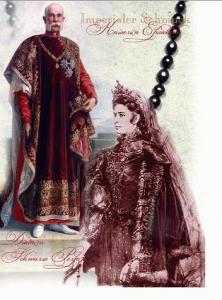
The Augustus Parents from the impressions of the "favorite daughter" of Sissi: Maria Valeria.
CONFESSIONS Diaries of 'Archduchess Marie Valerie, the favorite daughter of Elizabeth and Francis Joseph, reveal the' intimacy of a imperial couple tormented and tragic "God forgive my mother Sissi" A private document but also a portrait of a nude mom " tirelessly attracted by death. " "My father Franz Joseph hugged me and wept"
CONFESSIONS Diaries of 'Archduchess Marie Valerie, the favorite daughter of Elizabeth and Francis Joseph, reveal the' intimacy of a imperial couple tormented and tragic HABSBURGS God forgive my mother Sissi Franz Joseph and Elisabeth d 'Austria them closely. From very near, indeed: caught in 'intimate little imperial immobilized as in a daguerreotype' s time in moments of 'joy or despair. The early diary of their beloved daughter Maria Valeria, fourth child, at first glance reminds those gathered not-you-forget-me sigh that made the young ladies of good family. Only, instead of dried flowers or old theater tickets, you will find notes laced such as: "Mama always more oppressed. His fate is harder to bear when she is with dad. The sacrifice of their togetherness loses more and more sense. " Or, about a poem made to read 'illustrious father: "When you put the sheet's eyes were full of tears. Then I jumped up and kissed his hand, but he pulled her to him with fervor. Taking courage I took his head and kissed her as often as I want, but I never dared to do. I was ashamed for the 'embarrassment of novelty, but I think he did well ... ". There are revelations itchy, scandals unpublished or shameful vices, in the anthology of 'Archduchess Maria Valeria sees the light in these days in Italian (La favorite, the diary of his daughter Sissi Mgs Press). It tastes quite the taste of everyday life, only to subtract the two icons of the 'imaginary Central European to' prefabricated altar of devotion (or to 'the opposite of contempt). He, Franz Joseph, appears as a kindly grandfather and father troubled, ready to roll on the ground and be pulled along the famous favorites just to entertain a granddaughter, but unable to communicate with Maria Valeria soon as it comes out from children 'a complete and mature female personality. It 's like the same drive astonishment that paralyzes him in front of the enigmatic personality of his wife prevented him from confiding to his former favorite girl: so that, at each meeting, feels a sense of oppression and sees' s time to let him go, except continue to hope for a future spiritual communion with him. How to Sissi, the special relationship with the favorite daughter is the true leitmotif of the diary latter ', but also serves as a backdrop to the dark and tragic portrait of' Empress: obsessed by the need to travel to escape the duties of the court and hated those marital incomprehensible metaphysical haunted by ghosts and suspicion of the 'existence of a god evil persecutor, hostile to any human happiness; inclined to poetry and biased in so much of the myth of Byron to dream about it at night the ghost and make your torso erect villa in Corfu; tirelessly attracted by death, consciously cherished during the rides and countless sea crossings, touched at the time of the suicide of his son Rudolf in Mayerling, and finally reached the shores of Lake Geneva, at the hands of a terrorist. Faced with the thickness of the legendary two main actors, the 'author of the diary can only aspire to the role of appearance: simple and naive girl in the years 1878-83, has undergone several changes in adolescent-hearted, young restless, passionate girlfriend and finally devoted wife of Francesco Salvatore Grand Duke of Tuscany; evolves, then, without really understanding the political significance of what is happening around her. Grab the other hand, with increasing clairvoyance, that 'accumulation of unexpressed feelings and personal relationships unresolved intended to ruin the marriage of the parents and, in the long run, result in a tragedy not only for the Habsburgs, but it' s very existence of the multinational Austria Hungary . Almost as if, in the microcosm of Maria Valeria, is reflected and a harbinger of all that twilight world. The two august parents, therefore, are seen up close, perhaps too much to the point that their contours resulting deformed 's eccentricity of perspective. The watershed emotional, diary, coincides with the 'year 1889, one of the mysterious suicide of Rudolf in Mayerling: from that moment the eyes of Valeria misunderstandings between Franz Joseph and Sissi are deep, irreparable, while the girl begins to understand that even an imperial princess has the power to turn back time, and that the 'family harmony envisioned in' childhood will never be reached. Before his eyes evolves instead indecipherable spiritual and physical illness of the mother, more and more convinced of the 'injustice of being born subject to a distant and cruel god that she persists in calling Jehovah, unable to give an explanation to the physical suffering that the torment and misery of his own destiny. In the diary, May 12, 1898, are recorded bitter thoughts of Sissi: "Oh yes, I believe in God - so many misfortunes and suffering can not be the result of chance. He is powerful, frighteningly powerful and cruel - but I'm not complaining anymore. " And a month later, on June 17: "I'm not afraid to die, because I do not want to believe that there is an 'entity so cruel as to not settle for the sufferings of life and also tore the' soul from the body, to continue to torture ". Yet, the memories of Maria Valeria, peep also happy moments, as when the 'august Emperor, "former employee of' Austria-Hungary ', works tirelessly at his desk allowing the beloved daughter to share with him those moments of quiet devotion to duty, or when it agrees to play with her granddaughter Ella and bring astride the room, except leave it shocked the day when she shows up at imperial currency, the head of the dragons. Other pages of the diary, such as those describing the deaths of his brother Rodolfo and his mother, are those that remain in the memory. The records of 'Archduchess Valeria, the fragile girl destined to survive the catastrophe of six years of' Austria-Hungary, the two emblematic characters return to their very different humanity. Timeless in its archaic, feudal sense of duty the 'Emperor Franz Joseph strikingly modern in its neuroses, idiosyncrasies and weaknesses' s inimitable Sissi. Yet both, in opposite ways, seem to talk more than others sensitivity, even the imagination of generations of the concept of Central Europe orphan home. NEWS OF THE 'MURDER "My father Franz Joseph hugged me and wept" publish an excerpt from "The favorite, the diary of his daughter Sissi" of Maria Valeria' s Habsburgs, published by Mgs Press (Tel 040.44968, pages 304, pounds 32,000) September 10, 1898 in the evening at 6 and half returned from a tour with Mary at our poor ... souper ... then I went with the big three to pray in the chapel. Mary came with us, paid no attention much, I did not notice her expression troubled. I was more intimate than usual ... Maria asked me to come into his office, he had to tell me something. Still thinking of a small domestic problem, but when I looked, my heart stopped. "The 'Archduke?" "No - His Majesty." I do not know if there were any other questions or if I managed to say just the word "Dead?", If you said to me in the hallway or already in the room: "Murdered by an Italian anarchist - passed away in a hotel in Geneva." I do not know. I am still shaking my hand, when I think back to that time ... Repentance for having never returned to his great love and for all ... increasingly the 'unspeakable passion for him, the poor old father bent over with grief and sorrow ... Dad stood at the foot of the grand staircase of Schönbrunn and we threw each other 's arms of the' other. And for the first time was able to cry, he told me later. But even then it was still shocked. And soon after calm again, as then, the death of Rodolfo. We went to Sunday Mass together, and then I was able to spend this day almost constantly with him, sitting at his desk, while he was working as usual ... Dad seems to have immediately thought of an attack, even if repeated several times: "How can you kill a woman who did not hurt anyone?». Fertilio Dario Page 33 (26 April 2001) - CNN
From site http://archiviostorico.corriere.it/2001/aprile/26/ASBURGO_Dio_perdoni_mia_madre_co_0_010426361.shtml
Archduchess Marie Valerie of Austria............."The Only Child"
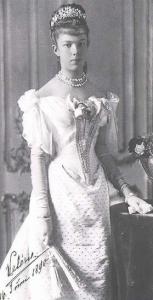
Archduchess Marie Valerie of Austria
Archduchess Marie Valerie of Austria (22 April 1868 – 6 September 1924) was the fourth and last child of Emperor Francis Joseph of Austria and Elisabeth of Bavaria ("Sisi"). Her given name was Marie Valerie Mathilde Amalie, but she was usually called Valerie.
Early life
Princess Marie Valerie was born at Ofen (Buda) in Hungary. The Empress Elisabeth was especially attached to Valerie, who was born ten years after the imperial couple's third child, and whom she was allowed to raise herself in contrast to her first three children who were taken from her in infancy and raised by the Emperor's mother, Archduchess Sophie. Sophie herself wrote to Elisabeth's mother Ludovika, "Sisi is completely absorbed by her love and care for this irresistible little angel."
She was Elisabeth's favorite child by far, and was acidly referred to by some courtiers as "Die Einzige" ("The Only Child") because Elisabeth paid so much more attention to her than her siblings. Valerie loved her mother, but according to her diaries, often felt embarrassed and overwhelmed by Elisabeth's concentration on her, particularly as she herself was of a modest and practical nature.
Another of Valerie's nicknames was "The Hungarian Child" because her birth had been a concession by Elisabeth, who disliked physical intimacy and pregnancy, in exchange for Franz Joseph's conciliation with Hungary, her most favored part of the Empire. This process culminated in their joint coronation in Budapest on 8 June 1867, as King and Queen of Hungary. Valerie was born just over nine months later.
Elisabeth deliberately chose Hungary as her child's birthplace; no royal child had been born in Hungary for centuries. Had Valerie been a boy, she would have been named Stephan after Hungary's canonized king and patron saint. According to historian Brigitte Hamann, a boy born to the Queen of Hungary in the castle at Budapest would have raised the possibility of his someday becoming its king, separating Hungary from the Austrian empire, and there was universal relief at the Viennese court that Valerie was a girl.
Malicious rumors intimated that Valerie was actually the daughter of Elisabeth's friend and admirer Gyula Andrassy, the Hungarian prime minister. These persisted into Valerie's childhood, hurting her deeply. However, she physically resembled Franz Joseph more than any of her siblings, even more so as she grew older, and eventually the rumors died away. Due to the atmosphere they created, however, Valerie developed a lifelong antipathy toward anything to do with Hungary, exacerbated by Elisabeth's insistence on speaking to her only in Hungarian. She was joyful when she was given permission to speak German with her father, whom she worshiped. In addition, she spoke English, French, and Italian fluently, loved to write plays and poems, and was a talented amateur artist who particularly enjoyed painting flowers. She was a great supporter of the Burgtheater in Vienna, and attended its productions as often as possible
Marriage
Franz Salvator and Marie ValerieIn Ischl on 31 July 1890, Valerie married her close cousin Archduke Franz Salvator. They had met in 1886 at a ball, but Valerie waited several years to be sure that her feelings toward Franz Salvator were strong enough to make a successful marriage. It was hoped by many at court that she would marry someone like the Crown Prince of Saxony or the Duke of Braganza, and she was also courted by Prince Alfons of Bavaria. Elisabeth, however, declared that Valerie would be allowed to marry even a chimney sweep if her heart were set on it (in contrast to her other children, who had both had to make dynastic marriages). Valerie chose for love Franz-Salvator, a relatively minor prince from the Tuscan branch of the Austrian imperial family who had no great wealth to offer, and Elisabeth, as promised, supported her favorite daughter. This caused a deep rift between Valerie and her sister and brother Crown Prince Rudolf for a time, but eventually Rudolf became reconciled to the marriage when Valerie and Franz became engaged at Christmas 1888.
Valerie's solemn renunciation of her rights to the Austrian throne, which was necessary for the marriage to proceed, took place on 16 July 1890 at the Hermesvilla.[1] The young couple's festive wedding followed in the parish church of Bad Ischl on 31 July. The ceremony was conducted by the Bishop of Linz, Franz Maria Doppelbauer. Afterwards, Valerie and Franz honeymooned in Italy, Switzerland, and Bavaria.
ChildrenMarie Valerie and Franz Salvator had 10 children:
Name Birth Death Notes
Elisabeth Franziska "Ella" 27 January 1892 29 January 1930 married Count Georg of Waldburg-Zeil-Trauchburg, had issue.
Franz Karl Salvator 17 February 1893 12 December 1918 died unmarried of the Spanish Flu.
Hubert Salvator 30 April 1894 24 March 1971 married Princess Rosemary of Salm-Salm, had issue.
Hedwig 24 September 1896 1 November 1970 married Count Bernard of Stolberg-Stolberg, had issue.
Theodor Salvator 9 October 1899 8 April 1978 married Countess Maria Theresa of Waldburg-Zeil-Trauchburg, had issue.
Gertrud 19 November 1900 20 December 1962 married Count Georg of Waldburg-Zeil-Trauchburg, widower of her sister Elisabeth, had issue.
Maria Elisabeth 19 November 1901 29 December 1936 died unmarried.
Clemens Salvator 6 October 1904 20 August 1974 married Countess Elisabeth Rességuier de Miremont, took the title Prince of Altenburg, had issue.
Mathilde 9 August 1906 18 October 1991 married Ernst Hefel, no issue.
Agnes 26 June 1911 26 June 1911 died at the age of eight hours.
Later life
At first, Valerie and Franz lived at Schloss Lichtenegg (Lichtenegg Palace). On 11 June 1895, the couple purchased Schloss Wallsee (Wallsee Palace) on the Danube River from its then owner, Alfred, Duke of Saxe-Coburg-Gotha and completely renovated it. When the renovation was finished, a ceremony marking their moving into the new palace was held on 4 September 1897. There was great celebration of the event in Wallsee due to Valerie's popularity.
She was known and loved for her generous involvement in local charitable endeavors. In 1900, she became a patron of the Red Cross, for which she founded hospitals and raised considerable sums of money; she was also patron of seven other charities. During World War I, she created a hospital barracks in the castle itself and helped care for the wounded. She was a devout Catholic who also spent much time supporting religious charities and was known to the people as the "Angel of Waldsee". She was also a Dame of the Star Cross Order.[2]
Valerie was greatly affected by the suicide of her brother Rudolf on 30 January 1889, and the assassination of her mother Elisabeth in September 1898. She and her sister Gisela were a great support to their father in the aftermath of these tragedies.
While the marriage of Valerie and Franz was harmonious at first, it became less so with time. Franz had many affairs, including one with Princess Stephanie von Hohenlohe (1891–1972), who was later known as "Hitler's Spy Princess" for her espionage activities before and during World War II. In 1914, she gave birth to a son by him, Franz Joseph, whom he acknowledged as his while Valerie was still alive. Valerie faced these blows stoically, confiding only in her journal.
After the end of World War I, Valerie officially recognized the end of the Habsburg monarchy and signed documents renouncing all rights toward the same for herself and her descendants. The renunciation allowed her to keep her home and possessions.
] Death
Valerie died in Schloss Wallsee on 6 September 1924 of lymphoma. Shortly before her death, her sister Gisela wrote in a letter, "I must add that I have seen Valerie - fully conscious, completely aware of her condition, and so devoutly accepting, even joyfully anticipating her impending departure, that I believe an unexpected recovery would actually disappoint her." She is buried in a crypt behind the high altar at the parish church in Sindelburg, Austria. Several thousand people followed her coffin to its resting place.
On 28 April 1934, ten years after Valerie's death, Franz married a second time, to Freiin (a title corresponding to "Baroness") Melanie von Riesenfels (20 September 1898 – 10 November 1984). This was a morganatic marriage; the wedding took place in Vienna. The pair had met after Valerie's death at Melanie's home, Seisenegg Palace, where she lived with her sisters Maria Anna and Johanna. After their wedding, the couple lived at Seisenegg.
Franz Salvator died on 20 April 1939 in Vienna.
The Mária Valéria bridge joining Esztergom in Hungary and Štúrovo in Slovakia, across the River Danube opened in 1895 is named after Marie Valerie.
da http://en.wikipedia.org/wiki/Archduchess_Marie_Valerie_of_Austria
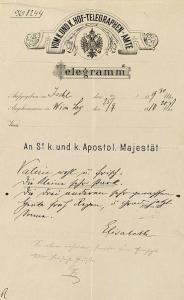
Telegram about M.Valerie
Ischl, 25. 9. 1896, the printed form of the offices for the imperial-royal telegrams.
"Valerie healthy and fresh. Younger very strong. The other three very grown up. Early morning rain, 5 degrees, the sun now. Elisabeth"
Franz: I just received, sends ... 1000 kisses heart FJ
GISELA HABSBURG-lORRAINE: THE FORGOT DAUGHTER OF SISI
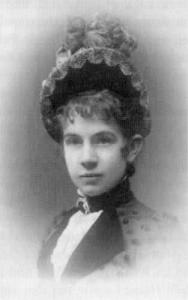
Gisella of Habsburg-Lorraine : the forgot daughter of Sisi
From Wikipedia online encyclopedia Gisella Maria Louise of Habsburg-Lorraine, Archduchess of Austria, Princess Royal of Hungary (Laxenburg, July 12, 1856 - Monaco of Bavaria, July 27, 1933) was the second daughter of Emperor Franz Joseph of Austria and Elisabeth of Bavaria. Biography [edit] Gisela of Austria. Childhood [edit] Although she had been baptized with two Gisella L, she always wrote his name with one L. Its name was chosen to commemorate the Princess Gisela of Bavaria, who married King Stephen I of Hungary and joined the Bavarian crown and Hungarian. Education of their children, Elizabeth and mother-in-law Sofia Wittelsbach had strong disagreements because the second was thought to be a duty to follow their education without consulting the wife. Once taken by anger and frustration, the Empress brought her daughters with her and Sofia Gisella in a state visit to his beloved Hungary. The girls fell seriously ill and the eldest died in just two years. Elizabeth blamed the incident and his rebellion turned into resignation. Marriage [edit] In 1873 Gisella married Leopold of Bavaria, becoming Princess of Bavaria. The marriage was frowned upon by many as detrimental to a daughter of the emperor. The couple went to live in Monaco of Bavaria. Upon his departure, the brother of Rodolfo Gisella wept much the loss of his childhood companion and even Franz Joseph was touched. The only one to appear more quiet was Elizabeth. Mother and daughter were in fact almost like two strangers, brought up in a different way: the latter was brought up strictly and impeccably as a perfect daughter imperial grandmother, while the first was raised free to run around the gardens and the woods of Possenhofen. Elizabeth helped still get her daughter's decision to marry Leopold convincing the husband and also the son himself, who had promised before the engagement to Princess Amalia of Saxe-Coburg-Kohary. Then Amalia was married Maximilian, brother of Elizabeth. Empire of Austria (1806-1866) Empire of Austria-Hungary (1867-1918) House of Habsburg-LorenaFrancesco I (1806-1835) and Grandchildren ■ ▼ mostraFigli Ludovica Elizabeth
■ Maria Luisa
■ Ferdinand I
■ Carolina Leopoldina
■ Carolina Luisa
■ Maria Leopoldina
■ Maria Clementina
■ Maria Carolina Ferdinanda
■ ■ Francis Charles Francis Joseph
■ Massimiliano
■ Charles Louis
■ Anna Maria
■ Louis Victor
■ Anna Maria
■ John of Nepomuk
■ Amalia Teresa
Ferdinand I (1835-1848) Franz Joseph I (1848-1916) and Grandchildren ■ ▼ mostraFigli Sofia
■ Gisella
Rodolfo ■ ■ Mary Elizabeth
■ Maria Valeria
Charles I of Austria (1916-1918) ▼ mostraFigli ■ Eight
■ Adelaide
■ Roberto
■ Happy
■ Charles Louis
■ Rodolfo
■ Carlotta
■ Elizabeth
Edit The marriage was happy and Gisella were spared by fate all the suffering he had endured his mother. Descent [edit] The couple had four children: Princess Elisabeth ■ Mary (1874-1957), who married Philip Otto Ludwig Graf von Seefried auf Buttenheim;
■ Princess Augusta Maria (1875-1964), who married Augustus Joseph of Habsburg-Lorraine, Archduke of Austria;
■ Prince George of Bavaria (1880-1943), who married the Archduchess Isabella of Austria-Teschen (canceled in 1913);
■ Prince Corrado (1883-1969) married Princess Bona Margherita of Savoy-Genoa (1896-1971).




